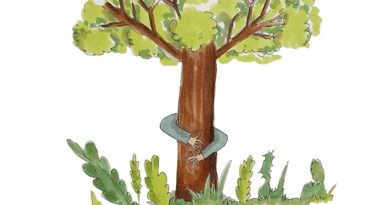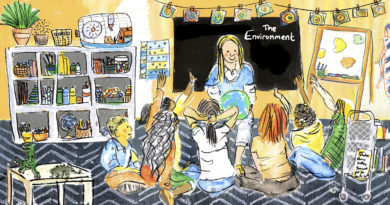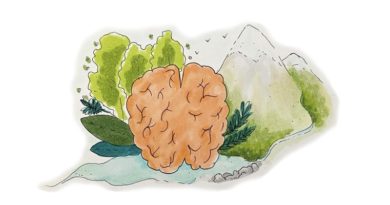From Darkness to Light: My Mindful Family
As the red mist descends and they just keep talking and crying and the dinner is burning and the house is a mess and you have forgotten the last time you wore a dress or perfume and the tears roll down your face and you feel so bad and guilty and nothing is right and the picture in your head of happy children bliss becomes something closer to mocking than a realistic goal…. And you feel that life is simply a black hole. That is the moment you feel you might do anything. That is the moment that challenges you beyond your wildest imagination.
For months after the birth of my first child, I thought things might improve. That I might find that joy and glow that all the other mothers talked so avidly about. But it never came. Finally, I found a sense of calm in a little white pill that I swallowed gratefully every morning. Although it never bought me the joy or the glow that others so clearly showed, it numbed the rage and dried the tears and it allowed me to, at the very least, pretend to be the mother that I so wanted to be. It came, however, with extras that I hadn’t anticipated. It may have put out the rage, but it also extinguished the possibility for joy, laughter and the chance to begin to understand the new, post-birth me. Now please don’t think that I am against anti-depressants; they can bring sanity to an insane world, but I needed to find another way.
Fast-forward seven years: a second birth, a diagnosis of Asperger’s for one of my babies, a move to a foreign country, and me, who although the same, is now also so very changed. There is no more little white pill. There are ups and downs, laughter and epic joy, but most of all there has been acceptance and compassion and love born out of mindfulness and meditation. I have made my journey along with my two little men, and the gift that I have been able to bestow upon them is priceless.
I’m a psychologist, so I’m not given to airy-fairy stuff; I enjoy solid science, research and results, so upon finding an abundance of well-researched information in support of the benefits and effectiveness of mindfulness, I threw myself into what might seem the ‘‘airy fairy business” of it…not only to aid women like myself who have survived post-natal depression, but for a host of other issues as well.
The most interesting aspect for me now is how mindfulness helps children, especially those with learning differences. Recent research by Van der Oord, et al. (2012), found a significant reduction in inattention, impulsivity and hyperactivity after just eight weeks of mindfulness training. Moreover, the parents became increasingly aware of their own mindfulness and became less over-reactive and less stressed with their children. The results seem obvious. Children were able to manage themselves more calmly in conjunction with parents who were calmer. Parents were able to manage their parenting more calmly with children who were calmer. This is the ultimate parenting goal, is it not? Calm, happy children; calm, happy parents. It seems that mindful parenting and mindful children may well be the best way to reach that parenting Nirvana!
Mindfulness is defined by Jon Kabat-Zinn as “paying attention in a particular way: on purpose, in the present moment, and non-judgmentally.” It’s the non-judgemental bit that has helped me and my children the most, although it has also been the most challenging part. Most humans spend their days judging each moment, themselves, and others from a foundation of assumptions that they don’t even know exist. These assumptions are often untrue, ingrained from birth, and can bring forth a whole host of issues, including expectations that are often unattainable.
A good example of an untrue assumption is the idea that we must be perfect. No one is perfect. By that assumption, we judge ourselves constantly under a light that is always too harsh. The most damaging aspect of this is the lack awareness, or lack of mindfulness. If you are not mindful of an assumption, it can never change. Practicing mindfulness enables us to begin to know ourselves and to pinpoint these assumptions before they trip ignited emotions and cause damage. This is not a practice in eradication; it is the practice of acceptance and non-judgement. By embodying this acceptance and self-knowledge, we are able to clearly see the emotions building moment by moment, day by day and thus forestall them. We can give these emotions the love and acceptance that they need to heal. Understanding them means that the emotional volcano within each of us doesn’t erupt, and instead we are able to move forward with the knowledge that, although the emotion is there, it is accepted rather than buried.
Of course the question is: how do we get our stroppy teenager or stomping five-year-old to be mindful? I believe the best way is to simply etch it into your life. The same way as all of your assumptions were ingrained from birth, so can mindfulness become the norm in your children’s lives. Starting younger is always easier, as children’s minds are so open and willing, but it is never too late!
Here is a sample meditation to manage fear with your child aged six years and up (from the Your Thoughts website). I recently used this meditation whilst on a ski lift with my son when obsessive thoughts of heights flooded his mind. Although this seems like eradication of emotion, we acknowledge the fear before we let it go:
Speak slowly and calmly to your child. Ask her to close her eyes and breathe gently. Now encourage her deepen her breaths. To feel the cool air on the tip of her nose as she breathes in. To slowly breathe out, feeling the warmth of the air on her top lip. She should start to feel comfortable and calmer after a few breaths.
Parent Question: What colour is your fear?
Child’s Answer: (for example) black
Parent Question: What colour is your happy?
Child’s Answer: (for example) blue
Ask your child to imagine that everything in front of her is black. Explain that it’s OK – we all feel fear, but now we are going to let it go. Now imagine that the blue is beginning to sweep away the edges of the black. We are letting go of the black, so that we have space for the blue. Slowly but very surely, the black is being swept away by blue.
Explain that as she breathes, everything in front of her will slowly turn from black to blue. Encourage her to keep breathing gently until all the black is gone and only the blue is left.
The Dalai Lama is quoted as having said: “If every eight-year-old in the world is taught meditation, we will eliminate violence from the world within one generation.” If that is the case, then isn’t it worth trying?
To embark upon your own mindful journey or to begin one with your family, follow the links below to a variety of practical resources.
Further reading and resources:
https://www.your-thoughts.com/mindfulness
https://bswa.org/teachers/ajahn-brahm/
www.cosmickids.com/tag/zen-den/
www.cosmickids.com/read/our-new-guided-relaxations-for-kids/
https://www.mindfulnesscds.com/
By Alison Kuhn
Alison Kuhn, MBPsS is the founder of Your Thoughts, a service set up to help parents manage the stresses of family life. She is a member of the British Psychological Society and is currently studying towards a master’s in health psychology with a focus on mindfulness. Alison has ten years’ experience within the special needs education sector and personal experience of raising a child with extra needs. To find out more about Your Thoughts please visit the homepage, follow us on Facebook or contact Alison at alison@your-thoughts.com.
Illustration by Laura Munteanu
Laura has studied Journalism and Advertising, and has been working as a journalist and an illustrator. She has been illustrating for magazines, websites, charity and diverse campaigns. She lives in Zurich with her husband and ten-year-old daughter.




